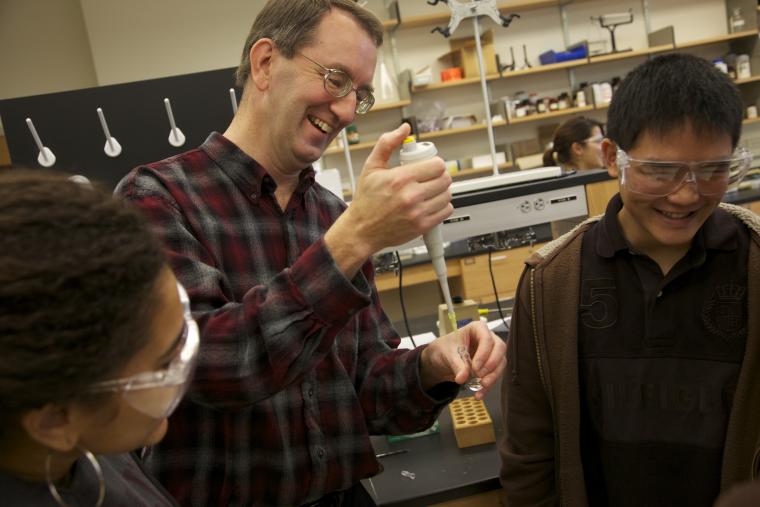Weird Science at Oberlin
October 11, 2013
Phoebe Hammer

Professor Robert Thompson shares a laugh with his Chemistry and Crime students during a lab.
Photo credit: Jennifer Manna
At Oberlin, studying the natural sciences doesn’t mean reading about abstract concepts in a dry textbook. Many departments, including chemistry, biology, geology, physics, and neuroscience, make strong efforts to offer classes that teach science in an unconventional way. From classes that focus on the sociological aspects of the brain to mysterious murder cases, professors at Oberlin are challenging students to explore the concept of “science” in a new and fascinating way.
Chemistry and Crime, taught by Chemistry Professor Robert Thompson, is one of the most popular among these classes. Throughout the semester, students gain an understanding of how chemical substances are structured, from atoms to molecules to macromolecules. But it’s not all about hard data. “We do science, but in the context of criminal investigation, which I think everyone has a natural interest in,” he says.
With a background in analytical chemistry and research for the FBI, Thompson has incorporated fieldwork, fingerprinting, and criminal investigation of cases such as the JFK murder and the O.J. Simpson case into the class, which has been offered since the late 1990s. "I want all students be able to read a newspaper and know the structure of a compound if they see it there,” says Thompson.
“It was great to integrate science in an interesting way,” says junior psychology major Heewon Kwon, who took the class last fall. “It was one of my favorite classes.”
Assistant Professor of Neuroscience Tracie Paine offers a new First-Year Seminar designed to teach science in a more philosophical way. The Synaptic Self covers basic neuroscience, including the parts of the brain and how neurons communicate, but builds up to higher cognitive functioning like personality and memory, and how the concept of “self” is created.
The class, which includes readings from philosophy to pop culture neuroscience to scientific articles, is highly discussion-based. “I’ve always wanted to teach a first-year seminar and I thought, ‘What do freshmen like? Themselves,’” says Paine. “At this age, it is the first time you can really express who you are and you are freed from the constraints of life in high school.”
Not only do unconventional science courses engage students, but they appeal to professors, as well. In fact, the opportunity to teach Musical Acoustics was one of the reasons why Assistant Professor of Physics Rob Owen decided to come to Oberlin. “I was a composition major before I went into physics,” he explains,. “It was a great fit for me.” The class, which draws many conservatory musicians and college students interested in sound, focuses on topics that “span the interface between science and music.”
While smashing wine bottles in class and rocking out, students are learning major physics concepts such as the behavior of waves, pressure, interference, diffraction, and the Doppler Effect. Office hours are as much about playing with sound on the keyboard as they are about solving equations.
“Even with so many [conservatory] students, he never presents the material for one type of person,” says college English major Graham McQueen. “He tailors it for con students and science students, and it’s never just throwing facts. It’s taught in a real-world kind of way.”
Indeed, teaching students how to use science in their lives is one of the primary functions of these classes. “What’s more important is that I teach what scientists do, how they think, and how they approach problems,” says Professor Thompson of his Chemistry and Crime class. “One of the biggest benefits of the liberal arts education is that you develop the ability to think in different disciplines.”
Brandt Rentel, environmental studies major and the president of Solarity, a student-run entertainment organization, took the class to gain life-long skills. “I thought knowing musical acoustics and resonance would be useful to know, for both Solarity and possibly event planning in my life,” he explains.
You may also like…
Josh Nolan Named Vice President, General Counsel, and Secretary at Oberlin
Distinguished attorney brings extensive experience in higher education law.
Learning by Teaching: Oberlin Students Share Global Music with Young Learners
College and Conservatory students in PACE 103 prepare local children for an immersive community concert at Oberlin.
Nuiko Wadden ’02 Joins Oberlin Conservatory Faculty as Assistant Professor of Harp
The versatile musician brings extensive opera, orchestral, and contemporary music experience to her role


